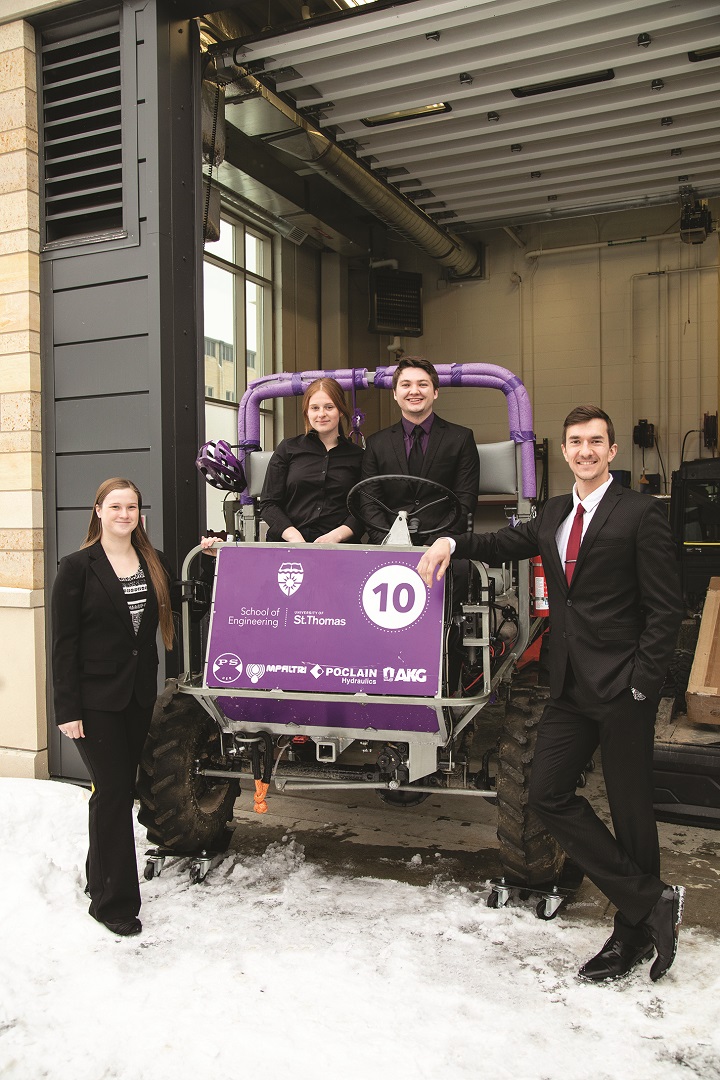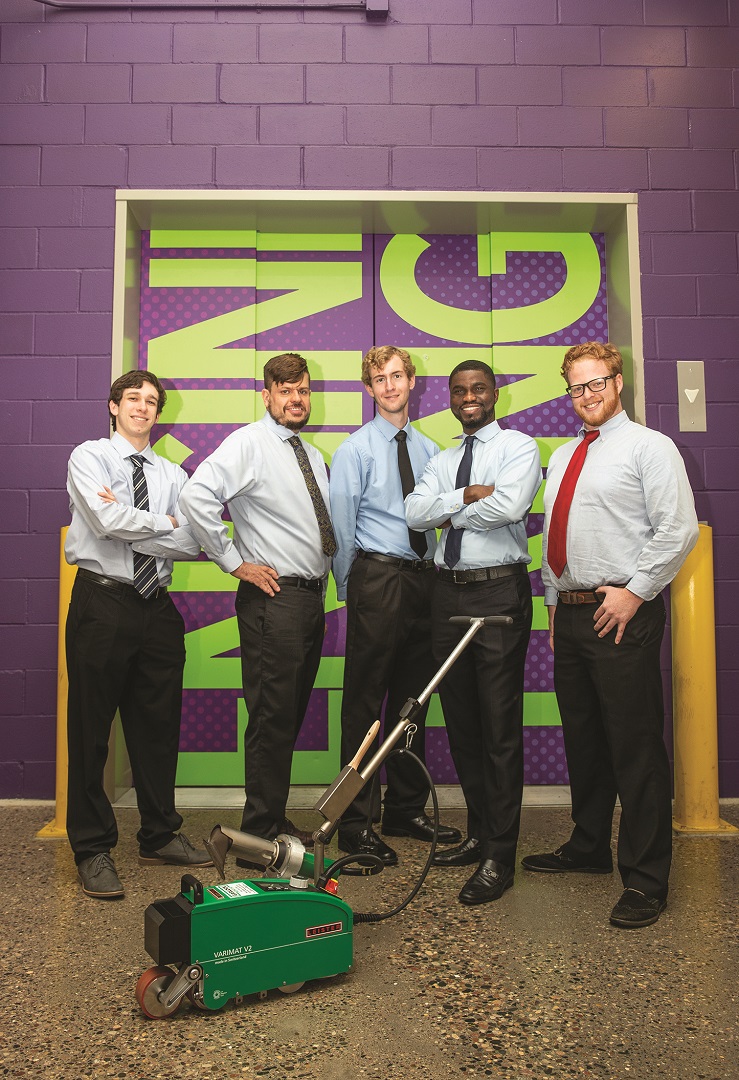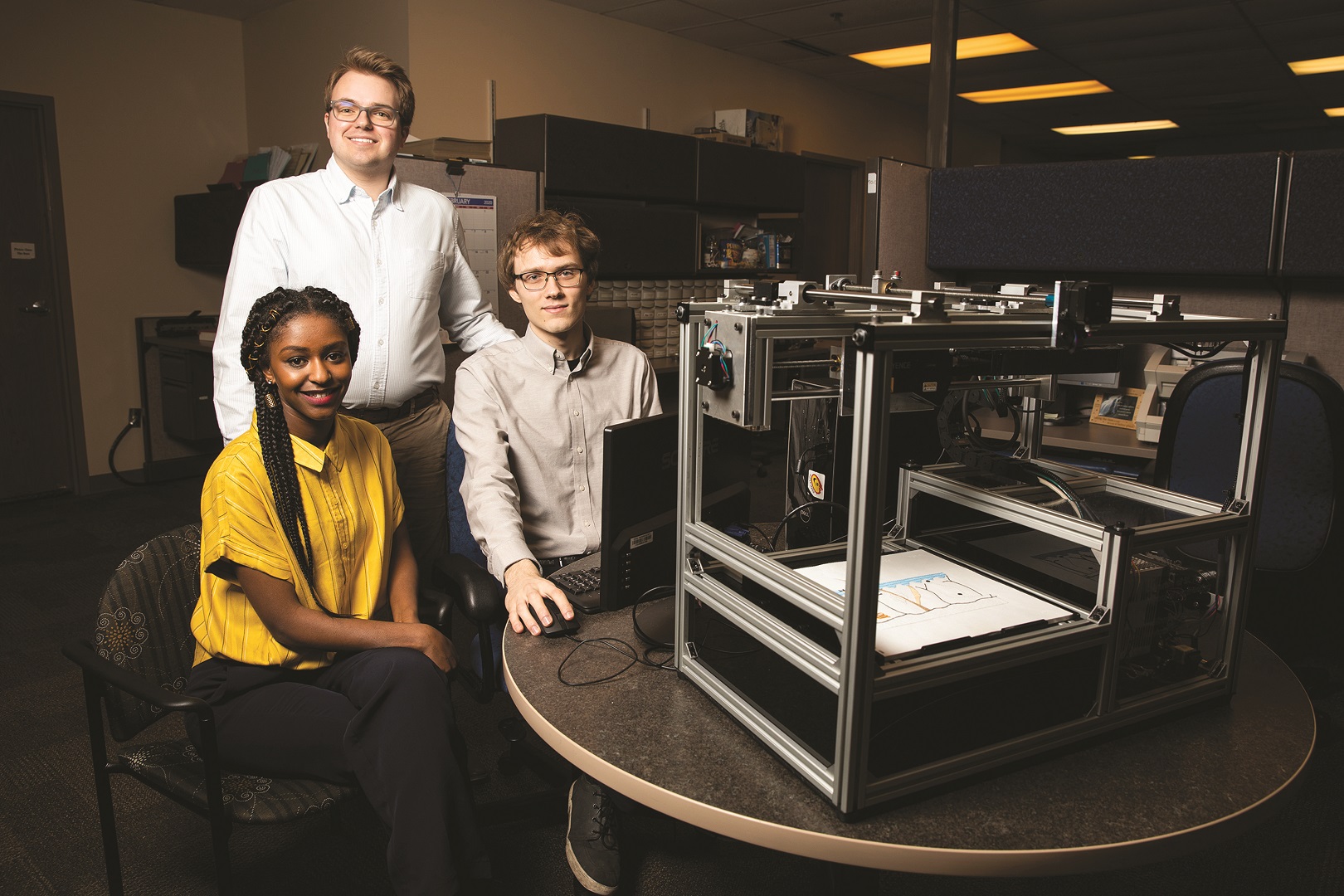This story is featured in the spring 2021 issue of St. Thomas Engineer.
While every engineering program delivers a capstone experience, the Senior Design Clinic at St. Thomas School of Engineering is building momentum around a unique national model that company sponsors are embracing.
In the clinic, students from all engineering majors enroll in the same two-semester course and are assigned to interdisciplinary teams to match skills with the expected project needs. With the assignment of all intellectual property to the sponsor, companies are not limited in bringing authentic, market-driven problems for the students to engage. The St. Thomas students lead their projects through a stage-gate design process requiring customer interviews, ideation, and design concept approvals from working engineers at each level. The projects culminate with students building, testing and validating a working prototype solution – not just written reports – for the sponsors.
This all has led to nearly 150 different organizations collaborating with the School of Engineering since the Senior Design Clinic’s inception in 2002. Partners over the years have ranged from start-ups and nonprofits to national brands, such as 3M, Target, Medtronic and Mayo Clinic.
“We’ve had very positive experiences with the Senior Design Clinic program within Target’s Global Supply Chain and Logistics Engineering organization,” said Target’s Director of Supply Chain Engineering Ryan Boudewyns ’04, ’08 MS in systems engineering. “It’s a very mature program where it is apparent that the faculty and staff have taken intentional efforts to prepare seniors to interact with a corporation in a professional manner and navigate through the project lifecycle independently.”
Engineering students have completed more than 30 projects for 3M since 2007. “It is a win-win situation. The collaboration gives students real-life experience, and it is the right thing to do from 3M’s standpoint because we are really trying to develop the next generations of engineers who will come and do great work for us,” said Doug Jensen, an electrical engineer in 3M’s Personal Safety Division, who was a project sponsor of a low-pressure flow meter.
Due to the COVID-19 pandemic, the Senior Design Clinic went fully virtual in 2020. “I and other 3Mers have been impressed with how the university has responded and how the students have adjusted to the new normal,” said 3M Senior Research Engineer Anna Hegdahl ’14. “The team I am currently working with continues to find new and creative ways to innovate and meet project deadlines.”
One team this academic year was sponsored by orthopedic surgeon Jay Davenport, of Davenport SAF-T Systems, to work on a personal safety device designed to diminish the impact of falls. Teams also have worked with Pelvital, a medical technology company focused on women’s health that recently received Food and Drug Administration clearance for its treatment to help women with stress urinary incontinence.
The work with nonprofits aligns with the St. Thomas commitment to the common good. One example was the development of the tactile diagram scanner for the Minnesota State Services for the Blind, a project that took three years, three teams and 13 students, with each team working on a portion of the project and handing it off to the next one.
Students described the tactile diagram scanner’s purpose as “digitally preserving original tactile diagrams – tactile representations of visual learning components in textbooks such as graphs, pictures and maps. By saving digital versions of the original physical diagrams, they are protected from damage and are more easily shared with teachers and students across the country.”
Another instance of nonprofit collaboration is work for north Minneapolis-based Pillsbury United Communities on a faster way of seeding the hydroponic farm where food is grown for the nonprofit’s wellness center and grocery store.
“It’s fun to see the diversity of projects every year,” Design Clinic Lead Dr. Tiffany Ling said.
Continuous growth
When the Senior Design Clinic started in 2002, there were six projects and mechanical engineering was the only major represented. Electrical engineering was added in 2004. The number of projects has steadily increased as well, with close to 40 projects for the 2020-21 academic year.

Students Janelle Mueller, Darya Klimok, Cooper Gray and Joshua Niemeyer partnered on the Basic Utility Vehicle (BUV) project, which is based on the Institute for Affordable Transportation’s mission to “bring safe affordable transportation to every person on the planet.” (Mark Brown/University of St. Thomas)
“The scale, rigor and the accomplishments of the students has changed over the years,” said Don Weinkauf, dean of the School of Engineering. “We’re getting groups of students who are better and better at scoping projects, and groups of seniors who have accomplished more and more, which can communicate to sponsors that there could be more and more expected of our students. Outside sponsors have said that the quality of the results and the work, the technical prowess demonstrated by our students, the capabilities of our students have all been growing.”
Numerous Senior Design Clinic projects have received patents, with students having the honor of their names listed on the patent.
"Creating challenging projects transforms students into champions,” Weinkauf said. “They start off thinking, ‘This is a project for 3M, Medtronic or Mayo Clinic,’ and then in a few months, they truly champion the project and put their heart and passion into it. That’s when amazing things happen.”
Another development over the years is the Global Summers program, which started in 2018. It’s an immersive experience for students, who spend seven to eight weeks in another country working with an organization. For the first Global Summers Senior Design Clinic project, five students spent seven weeks in Amman, Jordan, creating aspects of a dehydrator specifically for jameed, a dried yogurt that serves as the main ingredient of the popular Jordanian dish, mansaf. The project sponsor, the Jordanian Women’s Cooperative, sells jameed to partially fund their cooperative. It takes about a week for jameed to dry outside in the sun. “Our goal was to find a way to dry jameed faster, within maybe three days, so the women could output more and work year-round,” Kelly Mallon ’19, who worked on the project, told St. Thomas Newsroom in 2019. “That could potentially get them out of poverty and empower them.” Ensuing teams continued with the women’s cooperative.
In 2020, a team worked on a plastic mulch anchoring system for the School for International Training in Jordan. That system is designed to optimize the use of water in agricultural processes.
The Global Summers program expanded the previous year to Peru. The students collaborated with the Andean Alliance for Sustainable Development to design, test and build a machine that provides Peruvian farmers the option to reuse their corn and quinoa stalks for fertilization, compost and animal feed.
“The Global Summers program adds a level of difficulty in terms of delivery and listening to the customer,” Weinkauf said.
Even through the pandemic, the Global Summers program has continued remotely, with teams required to complete cultural training modules online.
“[The cultural training modules] enriched their experience and really helped them understand those cultural differences and how their design choices might change based on that knowledge of the difference in culture,” Ling said.
A better type of engineer
"The experience I had working on a Senior Design Clinic project was extremely useful in preparing me for the real world,” said Lindsey Falzone ’17 , now a systems engineer at Collins Aerospace who also is working toward a master’s degree in systems engineering at St. Thomas. “The presentations, timeline, deliverables, etc., are very similar to what happens in industry.”
Beyond engineering skills, Senior Design Clinic students learn how to successfully interact with clients, effectively communicate with each other and rely on each other over two semesters.
“Students can’t get it done by themselves, especially when there are multiple disciplines,” Ling said. “If a student is an electrical engineer, for instance, they can’t possibly learn all the mechanical engineering that they need to do a full project. They have to do the team dynamic of figuring out how to work together.”
Students also need to tap into what they have learned from their non-engineering courses as part of their St. Thomas liberal arts education.
“Engineering is about people. It’s about listening to people, moving people toward common goals, and delivering products and services for people,” Weinkauf said.
“The need for a liberal arts education is the need to understand humanity and the human condition, which engineers ultimately will serve. Listening, empathic design and understanding the voice of customers and the needs of society manifest in a liberal arts education. If those are absolute requirements of being a great engineer, then you can see the value of a liberal arts education in concert with the technical rigor that you get with an engineering degree.”

Students Leo Flentje, Adam Zopf, John Wallace, Alfred Danquah and Michael Hart created a robotic seam welder by adding automation, controls and a user interface to a manual device.
The ambiguity and complexity of engineering problem-solving stretches students as well; School of Engineering faculty and project sponsors alike appreciate the students’ growth over the two-semester course.
“It has been exciting to see the transformation from students who knew nothing about robotics and can quickly be able to adapt that and put it into process,” said Travis Dahlstrom ’09 MBA, a previous project sponsor and senior director of global engineering at Pentair spinoff nVent.
As two semesters can be a long time to work on one project, a new requirement of Senior Design Clinic students is a reflection paper to be done after the first semester. In the paper, students need to cover topics ranging from team collaboration to personal growth to how they tapped into learnings from non-engineering courses.
“If we don’t force students to take the time to reflect, they don’t necessarily do that on their own, because they get caught up in when the details of their assignments are due, and don’t sit back and think about how all of the pieces connect together,” Ling said.
With each year of graduates, the School of Engineering is preparing students to use what they have learned to improve the world.


